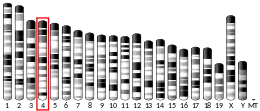Excitatory amino acid transporter 5
Excitatory amino-acid transporter 5 (EAAT5) is a protein that in humans is encoded by the SLC1A7 gene.[5][6]
EAAT5 is expressed predominantly in the retina, has high affinity for the excitatory amino acid L-glutamate. When stimulated by this amino acid, EAAT5 conducts chloride ions.[6]
References
- GRCh38: Ensembl release 89: ENSG00000162383 - Ensembl, May 2017
- GRCm38: Ensembl release 89: ENSMUSG00000008932 - Ensembl, May 2017
- "Human PubMed Reference:". National Center for Biotechnology Information, U.S. National Library of Medicine.
- "Mouse PubMed Reference:". National Center for Biotechnology Information, U.S. National Library of Medicine.
- "Entrez Gene: solute carrier family 1 (glutamate transporter)".
- Arriza JL, Eliasof S, Kavanaugh MP, Amara SG (April 1997). "Excitatory amino acid transporter 5, a retinal glutamate transporter coupled to a chloride conductance". Proc. Natl. Acad. Sci. U.S.A. 94 (8): 4155–60. Bibcode:1997PNAS...94.4155A. doi:10.1073/pnas.94.8.4155. PMC 20584. PMID 9108121.
Further reading
- Strausberg RL, Feingold EA, Grouse LH, et al. (2002). "Generation and initial analysis of more than 15,000 full-length human and mouse cDNA sequences". Proc. Natl. Acad. Sci. U.S.A. 99 (26): 16899–903. Bibcode:2002PNAS...9916899M. doi:10.1073/pnas.242603899. PMC 139241. PMID 12477932.
- Wistow G, Bernstein SL, Ray S, et al. (2002). "Expressed sequence tag analysis of adult human iris for the NEIBank Project: steroid-response factors and similarities with retinal pigment epithelium". Mol. Vis. 8: 185–95. PMID 12107412.
- Boehmer C, Rajamanickam J, Schniepp R, et al. (2005). "Regulation of the excitatory amino acid transporter EAAT5 by the serum and glucocorticoid dependent kinases SGK1 and SGK3". Biochem. Biophys. Res. Commun. 329 (2): 738–42. doi:10.1016/j.bbrc.2005.02.035. PMID 15737648.
- Gratacòs M, Costas J, de Cid R, et al. (2009). "Identification of new putative susceptibility genes for several psychiatric disorders by association analysis of regulatory and non-synonymous SNPs of 306 genes involved in neurotransmission and neurodevelopment". Am. J. Med. Genet. B Neuropsychiatr. Genet. 150B (6): 808–16. doi:10.1002/ajmg.b.30902. PMID 19086053.
- Ota T, Suzuki Y, Nishikawa T, et al. (2004). "Complete sequencing and characterization of 21,243 full-length human cDNAs". Nat. Genet. 36 (1): 40–5. doi:10.1038/ng1285. PMID 14702039.
This article is issued from Wikipedia. The text is licensed under Creative Commons - Attribution - Sharealike. Additional terms may apply for the media files.



